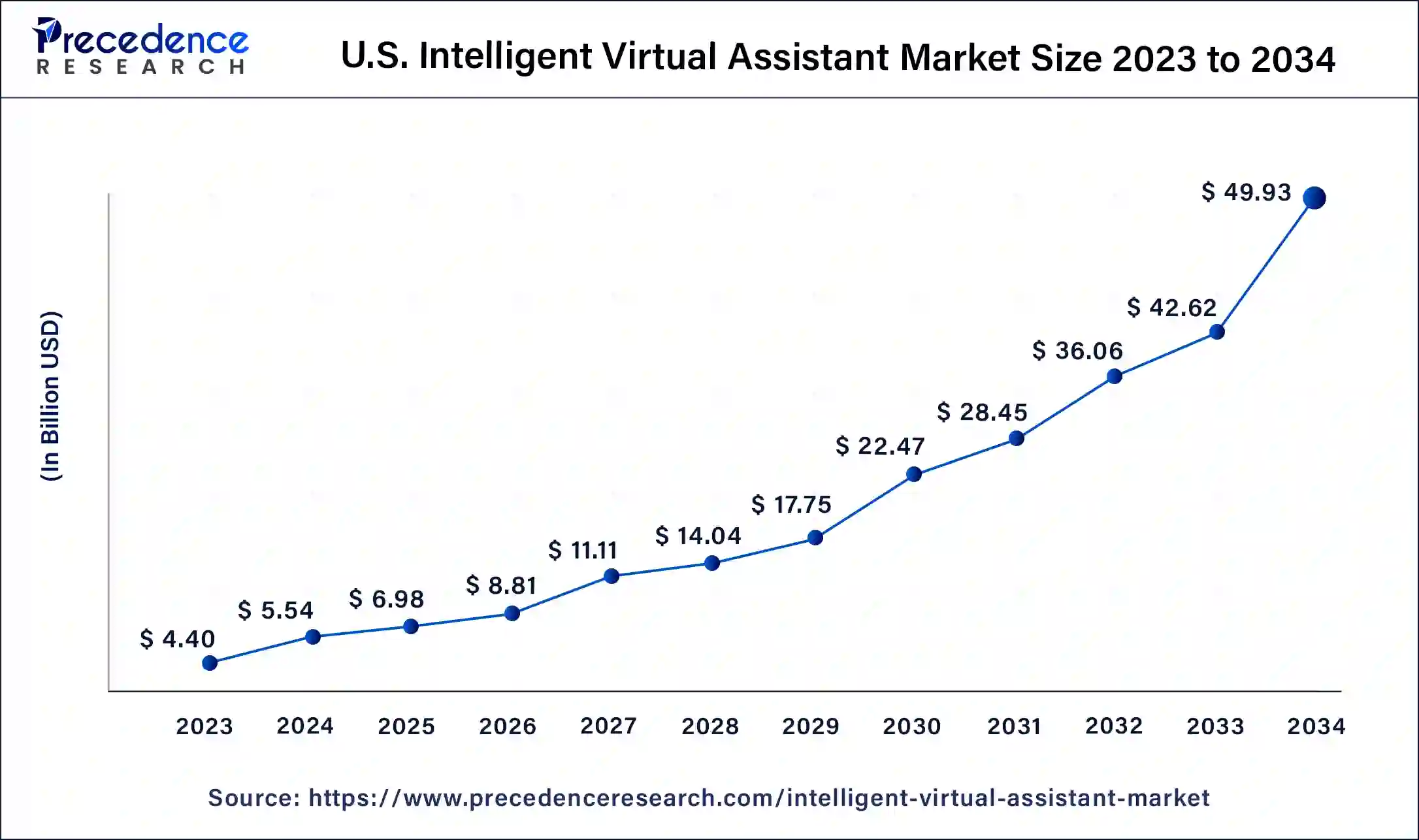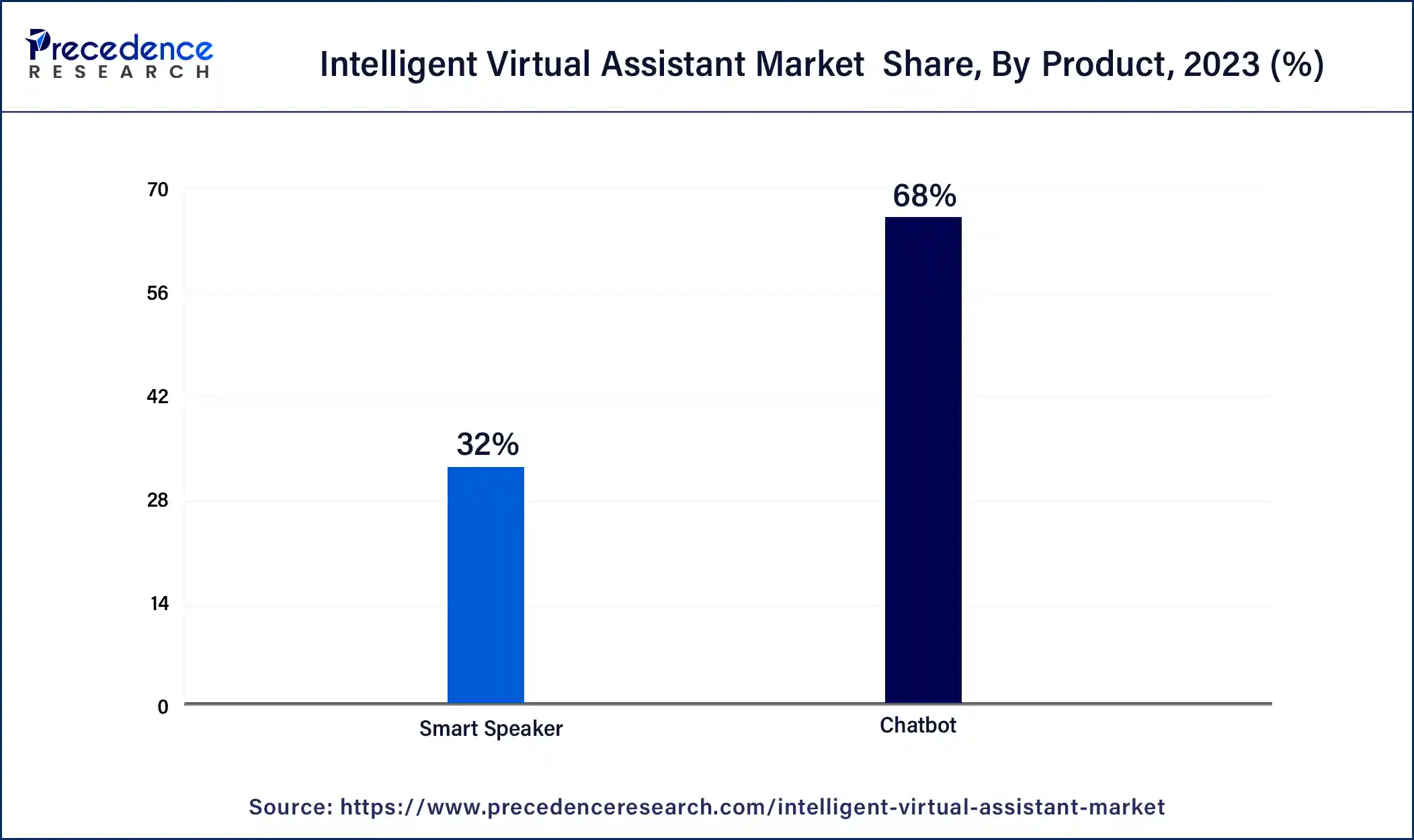November 2024
Intelligent Virtual Assistant Market (By Product: Chatbot, Smart Speaker; By Procedure: Automatic Speech Recognition, Text to Speech, Text-based, Others; By End User: BFSI, Consumer Electronics, Automotive, Healthcare, Education, Retail, IT & Telecom, Travel & Hospitality, Others) - Global Industry Analysis, Size, Share, Growth, Trends, Regional Outlook, and Forecast 2024-2034
The global intelligent virtual assistant market size was USD 16.08 billion in 2023, accounted for USD 20.21 billion in 2024, and is expected to reach around USD 178.80 billion by 2034, expanding at a CAGR of 24% from 2024 to 2034. North America intelligent virtual assistant market size reached USD 4.99 billion in 2023.

The U.S. intelligent virtual assistant market size was estimated at USD 4.40 billion in 2023 and is predicted to be worth around USD 49.93 billion by 2033, at a CAGR of 24.59% from 2024 to 2034.

North America has held the largest revenue share 39% in 2023. The intelligent virtual assistant (IVA) market is thriving in North America, driven by the widespread adoption of cutting-edge technologies and the dominant presence of major technology companies. The region is experiencing a notable rise in the integration of IVAs across diverse industries, with a specific focus on enhancing customer service applications. This emphasis on customer service applications is contributing significantly to improvements in operational efficiency and overall user experience across various sectors in the North American market.

Asia Pacific is estimated to observe the fastest expansion. In Asia Pacific, the IVA market is undergoing rapid expansion, driven by the continuous development of digital infrastructure and a surging demand for automation in diverse business processes. The region benefits from a growing tech-savvy population, coupled with substantial investments in artificial intelligence technologies, fostering a dynamic and thriving market landscape.
In Europe, the intelligent virtual assistant (IVA) market is witnessing steady growth, marked by increasing recognition of the benefits IVAs bring to businesses. The region is characterized by a rising implementation of IVAs in sectors like finance, healthcare, and retail, aiming to optimize operations and elevate customer engagement. Europe's evolving technological landscape and the drive for enhanced operational efficiency contribute to the expanding adoption of IVAs across industries in the European market.
The intelligent virtual assistant market is a rapidly growing sector characterized by AI-powered virtual agents designed to perform tasks and provide information through natural language processing. IVAs find applications in customer service, healthcare, and smart homes, enhancing user interactions. Key players offer advanced features like speech recognition, personalized responses, and integration with various platforms. The market's expansion is driven by the increasing demand for automation, efficiency, and improved customer experiences, with IVAs playing a pivotal role in transforming how businesses and individuals interact with technology.
Intelligent virtual assistants are deployed across industries, addressing diverse needs such as virtual customer support, appointment scheduling, and data analysis. The market's evolution includes advancements in emotion recognition, language understanding, and expanding use cases, solidifying IVAs as indispensable tools in modern digital ecosystems.
| Report Coverage | Details |
| Growth Rate from 2024 to 2034 | CAGR of 24% |
| Market Size in 2023 | USD 16.08 Billion |
| Market Size in 2024 | USD 20.21 Billion |
| Market Size by 2034 | USD 178.80 Billion |
| Largest Market | North America |
| Base Year | 2023 |
| Forecast Period | 2024 to 2034 |
| Segments Covered | Product, Procedure, End User, and Region |
| Regions Covered | North America, Europe, Asia-Pacific, Latin America, and Middle East & Africa |
Advancements in Natural Language Processing (NLP) and growing demand for virtual customer support
The surge in the market demand for intelligent virtual assistants (IVAs) is propelled by two key factors, advancements in natural language processing (NLP) and the growth in demand for virtual customer support. The continuous evolution of NLP technologies has empowered IVAs to comprehend and respond to user queries with increasing sophistication. Enhanced language understanding allows IVAs to engage in more nuanced conversations, providing users with a seamless and natural interaction experience.
Simultaneously, the escalating demand for virtual customer support solutions across industries has positioned IVAs as integral components of modern business strategies. As businesses prioritize efficient and responsive customer interactions, IVAs play a pivotal role in delivering real-time assistance, resolving queries, and offering personalized support. Their ability to understand context, interpret user intent, and learn from interactions contributes to elevated customer satisfaction. These dual forces, NLP advancements and the demand for superior customer support underscore the dynamic growth trajectory of the IVA market as organizations seek intelligent, automated solutions to enhance customer engagement and streamline operations.
Privacy concerns and integration challenges
One significant restraint for the intelligent virtual assistant (IVA) market is the growing concern around user privacy. As these virtual assistants become more ingrained in daily life, there is an increasing amount of sensitive and personal information being processed. Users are becoming more cautious about the data collected by IVAs and how it's used. Privacy breaches, data mishandling, or unauthorized access to personal information can erode user trust. Striking a balance between providing personalized experiences and ensuring robust privacy measures will be crucial for the sustained growth of the IVA market.
Integration challenges pose another hurdle for the IVA market. Deploying IVAs seamlessly into existing systems and workflows can be complex, particularly for businesses with diverse and legacy systems. Compatibility issues, interoperability challenges, and the need for customized integration can slow down the adoption of IVAs. Organizations must invest in skilled personnel and resources to ensure smooth integration with their IT infrastructure. Overcoming these challenges is essential to maximize the benefits of IVAs and fully leverage their potential across various industries.
Enhanced customer experience and increased efficiency in business processes
The increasing adoption of intelligent virtual assistants (IVAs) is closely tied to their capacity for improving customer experiences and streamlining business operations. IVAs, empowered by advanced natural language processing (NLP) and machine learning, deliver responsive and personalized interactions to users. Their ability to understand and respond to natural language makes interactions more intuitive and satisfying for customers.
This technological sophistication contributes significantly to enhancing overall customer satisfaction and loyalty by providing a seamless and personalized engagement experience. This not only improves customer satisfaction but also contributes to brand loyalty. In customer support scenarios, IVAs offer real-time assistance, quickly resolving queries and providing information. Their continuous learning abilities enable them to understand user preferences, adapting their responses over time for a more tailored and efficient customer experience.
Moreover, businesses are increasingly leveraging IVAs to optimize internal processes. These virtual assistants excel in handling routine and repetitive tasks, freeing up human resources to focus on more complex and strategic activities. In corporate settings, IVAs assist with data retrieval, scheduling, and information management, contributing to increased operational efficiency. As organizations prioritize delivering superior customer service and optimizing workflows, the demand for Intelligent Virtual assistants continues to surge, marking a transformative shift in how businesses engage with customers and manage their internal operations.
According to the product, the chatbots segment held a 68% revenue share in 2023. Chatbots, a key segment of Intelligent Virtual Assistants (IVAs), are AI-powered conversational interfaces that facilitate communication between users and computer systems. They use natural language processing (NLP) to understand and respond to user queries, offering a seamless conversational experience. Trends in chatbots involve advancements in contextual understanding, multilingual capabilities, and integration with various platforms, enhancing user engagement across industries, from customer service to e-commerce.

The smart speakers segment is anticipated to expand at a significant CAGR of 32.8% during the projected period. Smart speakers are voice-activated devices equipped with virtual assistants, providing hands-free interaction and access to various services. Trends in smart speakers include improved voice recognition accuracy, expanded language support, and integration with smart home devices. As these devices evolve, they're becoming central to smart home ecosystems, offering users voice-controlled access to music, information, and home automation, fostering a more connected and convenient lifestyle.
Based on the technology, the text-to-speech segment held the largest market share of 61% in 2023. Text-to-Speech (TTS) technology in intelligent virtual assistants (IVAs) involves the conversion of written text into spoken words. The current trend in TTS is marked by continuous advancements in natural language processing, resulting in more lifelike and expressive virtual voices. These developments aim to create a more engaging and human-like interaction between users and virtual assistants.
On the other hand, the automatic speech recognition segment is projected to grow at the fastest rate over the projected period. Automatic speech recognition technology enables IVAs to convert spoken language into written text. The latest trend in ASR is the improvement of accuracy and speed, allowing virtual assistants to better understand and respond to spoken commands or queries. Ongoing innovations aim to enhance the overall effectiveness and efficiency of voice-based interactions in IVAs.
The consumer electronics segment had the highest market share of 32% in 2023 based on the application. intelligent virtual assistants (IVAs) in consumer electronics refer to voice-activated assistants integrated into smart devices like smart speakers, smartphones, and smart home systems. The trend in this application involves the growing integration of IVAs into various consumer electronics to enable voice commands for tasks such as setting reminders, playing music, and controlling smart home devices. Improved voice recognition technology and expanded functionalities contribute to a more seamless and intuitive user experience in consumer electronics.
The healthcare segment is anticipated to expand at the fastest rate over the projected period. In healthcare, intelligent virtual assistants are designed to assist both healthcare professionals and patients. They provide information, schedule appointments, offer medication reminders, and answer health-related queries. The trend in healthcare IVAs includes increased adoption for tasks like appointment scheduling, telehealth consultations, and delivering personalized health information. The integration of AI-driven virtual assistants in healthcare aims to enhance operational efficiency, improve patient engagement, and provide timely and accurate information, contributing to better overall healthcare outcomes.
Recent Developments
Segments Covered in the Report
By Product
By Procedure
By End User
By Geography
For inquiries regarding discounts, bulk purchases, or customization requests, please contact us at sales@precedenceresearch.com
No cookie-cutter, only authentic analysis – take the 1st step to become a Precedence Research client
November 2024
July 2024
November 2024
November 2024